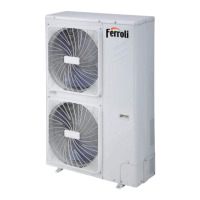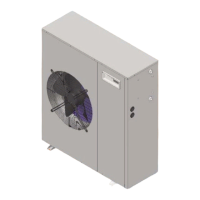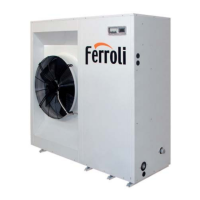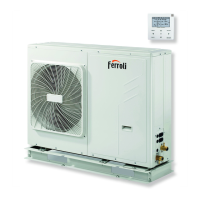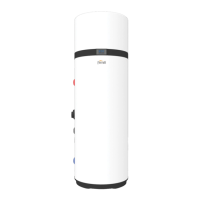90
EN
Cod. 3541T090 - Rev. 00 - 06/2019
MAINTENANCE
Bad fixing gives rise to noise and abnormal vibrations.
• Inspection of hydraulic circuit
Check visually to make sure that there are no leaks in the hydraulic circuit. Check that water lters are clean.
• Inspection of electrical system
Make sure that power cables that supply the unit are not torn, cracked or damaged in a way that could impair its insulation.
Perform a thorough visual inspection of the components of the electrical panel to check for the presence of damaged or not well connected components or cables
(check the tightening of the terminal screws).
• Inspection of the ventilated condensing/evaporating section
WARNING: e nned pack exchanger has ns made of aluminium or some other thin material, thus even accidental contact could cause cuts.
Condensing/Evaporating coils
In view of the function of this component, it is very important for the surface of the exchanger to be as free as possible from clogging caused by items that could reduce the fan’s air ow rate and, thus, the
performances of the unit itself.
e following operations may be required:
- Remove all impurities (such as paper scraps, leaves, etc.) that could be clogging the surface of the bank either by hand or using a brush (comply with the above mentioned safety prescriptions).
- If the dirt has deposited on the ns and is dicult to remove by hand, use a ow of compressed air or pressurized water on the aluminium surface of the coils, remembering to direct the ow in a vertical
and opposite to the standard ow direction to prevent the ns from being damaged.
- “Comb” the coils with the relative tool, using the appropriate comb spacing for the ns if some parts of them are bent or squashed.
Axial fans
Visually inspect these parts to make sure that the fans are well xed to the bearing grille and that this latter is xed to the structure of the unit. Check the fan bearings, and close the terminal box and cable
glands. Bearings damaged and bad xing are the source of abnormal noise and vibrations,
• Heat pump - Inspection of the water heat exchangers
e exchangers must ensure the maximum heat transfer possible so keep them clean and free from dirt that may reduce eciency; make sure that the temperature dierence between water outlet temperature
and evaporation/condensation does not increase over time, if the dierence exceeds 8 -10 ° C it is necessary to proceed cleaning the water side of the exchanger, keeping in mind the following: water circulation
must be in the opposite direction than normal, the uid velocity does not exceed 1.5 times the nominal velocity and use just water or moderately acid products but only water for nal washing.
• Inspection of the water lters
Make sure to clean the lter and remove any impurities that block the proper ow of water, contributing to increase pressure drop and therefore energy consumption of the pumps. Refer to the section
“Hydraulic Connections” too.
• Heat pump - Inspection of the water pumps
Check water leakages, the state of the bearings, the closing of the terminal box and integrity of the cable. Bearings damaged and bad xing are the source of abnormal noise and vibrations,
BCAUTION
As a result of extraordinary maintenance on the cooling circuit with component replacement, before restarting the
machine, perform the following steps:
- Pay attention to restore the refrigerant charge indicated on the name plate of the machine.
- Open all the ball valves in the refrigerant circuit.
- Correctly connect the power supply and grounding.
- Check the hydraulic connections.
- Check that the water pump is working properly.
- Clean water filters.
- Check that the finned coils are not dirty or clogged.
- Check the proper rotation of fans.
- Check correct operation of safety devices with particular attention to differential water pressure switch and / or
water flow switch.
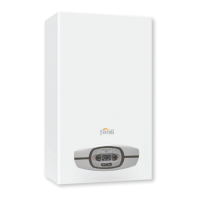
